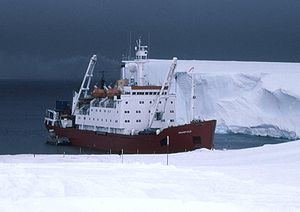Name RRS Bransfield Yard number 508 Draft 6.7 m | Length 99 m | |
 | ||
Route Antarctic Research and Logistics | ||
RRS Bransfield was an ice-strengthened cargo vessel, purpose-built for the British Antarctic Survey (BAS).
Contents
History
RRS Bransfield was designed by consultants Graham & Woolnaugh of Liverpool for NERC, and built by Robb Caledon Shipbuilders Ltd, Leith. She was named after Edward Bransfield RN (1785-1852), who discovered the north west coast of the Antarctic Peninsula, roughly surveyed the South Shetland Islands, claiming King George Island and Clarence Island for Great Britain. Bransfield was the first man to chart part of the Antarctic mainland.
This was the second vessel to be named after Bransfield by BAS or its predecessors. The first was HMS Bransfield, the original expedition ship for Operation Tabarin, a secret British expedition to Antarctica during World War Two. It established the first permanent British bases on the Antarctic Peninsula and became the Falkland Islands Dependencies Survey in 1945 (renamed BAS in 1962). This vessel was a wooden Norwegian sealer built in 1918 as the Veslekari, and renamed for the expedition. Her service with Tabarin was inglorious - she proved to be unseaworthy, and had to be replaced before the expedition left English waters in November 1943.
In 1993/94, while in the Weddell Sea Bransfield suffered an engine room fire.
In May 1999, she was sold to GC Rieber Shipping as part of the contract for the long-term charter of her replacement, RRS Ernest Shackleton. She was subsequently renamed Igenpearl, and was scrapped in Mumbai in 2000.
Service
RRS Bransfield was BAS's main supply vessel for 29 years, from 1970/71 to 1998/99. She also had limited facilities for on-board research. There was a fully equipped hospital bay on board.
For much of her career her joint Masters were John Cole and Stewart Laurence. Bransfield represented NERC in the Review of the Fleet at Spithead in 1977, held to celebrate Queen Elizabeth II's jubilee.
